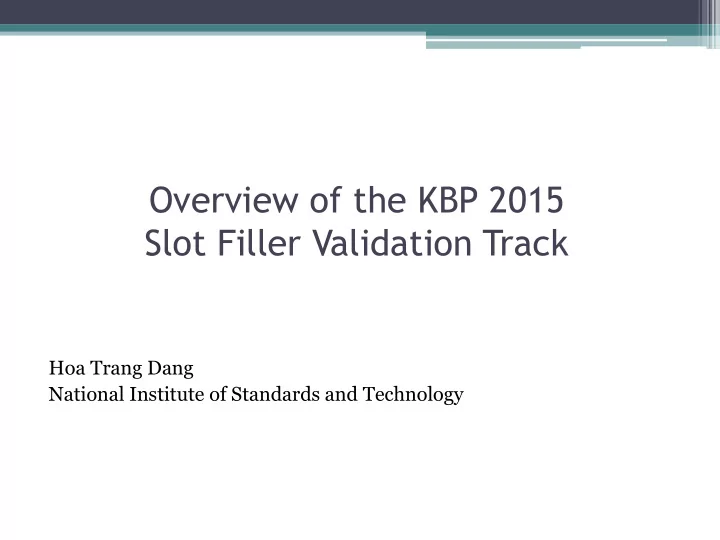

Overview of the KBP 2015 Slot Filler Validation Track Hoa Trang Dang National Institute of Standards and Technology
Slot Filler Validation (SFV) • Track Goals ▫ Allow teams without a full slot-filling system to participate in KBP, focus on SF answer validation rather than IR, IE, EDL, etc. ▫ Evaluate the contribution of RTE systems on KBP slot-filling ▫ Allow teams to experiment with system voting and ensembling • Piggy back off of resources developed for and by KBP [Cold Start] Slot Filling • Task and evaluation metrics depend on use case and availability of additional information about candidate fillers ▫ RTE: correctness of candidate slot filler is judged in isolation – no knowledge of who proposed the candidate slot filler. Generally requires going back to the source documents ▫ SFV: candidate slot fillers grouped according to which system propose the slot filler – leverage wisdom of the crowd
SFV 2015 • SFV input: ▫ All KBP 2015 CS Slot Filling input (slot definitions, CSSF queries, source documents) ▫ Anonymized individual CS KB/SF runs SFV2015_KB_12_5 SFV2015_KB_2_1 SFV2015_SF_2_1 ▫ System profile for each CS run (“are the confidence values meaningful?”) ▫ Preliminary assessment of ~10% of CSSF queries (164 / 1983) ▫ Mapping to real team names (extra) SFV2015_KB_12 = “BBN” SFV2015_KB_2 = “Stanford KB” SFV2015_SF_2 = “Stanford SF” • SFV output: Binary classification of each candidate slot filler in each CS run (-1/+1 : Exclude/Include slot filler)
Task 1: SFV Filtering Task • Apply SFV filter to set of original CS runs to produce a filtered version of each original CS run. • Can only improve Precision, not Recall, of individual CS runs • Score each original and filtered CS run with Cold Start scorer, and report change in F1 • Final SFV Filtering score = mean change in F1, over all CS runs • How much can you improve an individual CS run, on average?
Task 2: SFV Ensemble Task • Apply SFV filter to set of original CS runs to produce a single ensemble CS run • Possible to improve both Precision and Recall over original CS runs • Score ensemble CS run with Cold Start scorer • Final SFV Ensemble score = F1 of the ensemble run
Applying Cold Start scorer in SFV • CS scorer penalizes a CS run for returning multiple slot fillers that are duplicates (refer to the same entity, concept, etc.). • SFV must optimally remove duplicate “Correct” candidate slot fillers within a CS run and (for ensemble) across the set of CS runs. • Identifying that different Cold Start entry points are for the same entity is currently outside the scope of SFV • SFV evaluation focuses on micro-average Cold Start scores -- each correct slot filling answer (equivalence class) is weighted evenly. • Score only on the 90% of CSSF queries that did not have preliminary assessments released as part of the SFV input
SFV 2015 Participants Team Organization Confidence Assessment * gator_dsr University of Florida Yes Yes jhuapl Johns Hopkins University Yes Yes Applied Physics Laboratory RPI_BLENDER Rensselaer Polytechnic Institute No Yes UI_CCG University of Illinois Urbana No Yes Champaign * UTAustin University of Texas at Austin Yes Yes * SFV team was provided with real identity of Cold Start teams (build on UTAustin work on supervised ensembling)
-0.1 jhuapl1 filter (cssf micro-average) 0.2 0.3 0.4 0.5 0.1 0 SFV2015_KB_12_1 SFV2015_KB_12_2 SFV2015_KB_12_4 SFV2015_SF_03_1 SFV2015_KB_05_4 SFV2015_SF_18_1 SFV2015_SF_18_3 SFV2015_SF_03_2 SFV2015_SF_08_3 SFV2015_SF_03_4 SFV2015_SF_08_4 SFV2015_SF_10_1 SFV2015_KB_16_1 SFV2015_KB_16_5 SFV2015_SF_10_3 SFV2015_KB_16_3 SFV2015_SF_08_1 SFV2015_SF_13_3 SFV2015_SF_08_5 SFV2015_KB_10_2 SFV2015_KB_10_4 SFV2015_SF_06_1 SFV2015_SF_04_1 SFV2015_SF_13_4 SFV2015_SF_04_2 SFV2015_SF_02_2 SFV2015_SF_02_4 SFV2015_SF_14_1 SFV2015_SF_07_1 SFV2015_SF_07_5 SFV2015_SF_04_5 SFV2015_SF_17_1 SFV2015_KB_11_1 SFV2015_SF_17_3 SFV2015_KB_11_2 post-filter hop0 change Orig hop0 F
RPI_BLENDER1 filter (cssf micro-average) -0.05 0.05 0.25 0.35 0.45 0.15 -0.1 0.2 0.3 0.4 0.1 0 SFV2015_KB_12_1 SFV2015_KB_12_2 SFV2015_KB_12_4 SFV2015_SF_03_1 SFV2015_KB_05_4 SFV2015_SF_18_1 SFV2015_SF_18_3 SFV2015_SF_03_2 SFV2015_SF_08_3 SFV2015_SF_03_4 SFV2015_SF_08_4 SFV2015_SF_10_1 SFV2015_KB_16_1 SFV2015_KB_16_5 SFV2015_SF_10_3 SFV2015_KB_16_3 SFV2015_SF_08_1 SFV2015_SF_13_3 SFV2015_SF_08_5 SFV2015_KB_10_2 SFV2015_KB_10_4 SFV2015_SF_06_1 SFV2015_SF_04_1 SFV2015_SF_13_4 SFV2015_SF_04_2 SFV2015_SF_02_2 SFV2015_SF_02_4 SFV2015_SF_14_1 post-filter hop0 change Orig hop0 SFV2015_SF_07_1 SFV2015_SF_07_5 SFV2015_SF_04_5 SFV2015_SF_17_1 SFV2015_KB_11_1 SFV2015_SF_17_3 SFV2015_KB_11_2
-0.05 gator_dsr3 filter (cssf micro-average) 0.05 0.25 0.35 0.45 0.15 0.2 0.3 0.4 0.1 0 SFV2015_KB_12_1 SFV2015_KB_12_2 SFV2015_KB_12_4 SFV2015_SF_03_1 SFV2015_KB_05_4 SFV2015_SF_18_1 SFV2015_SF_18_3 SFV2015_SF_03_2 SFV2015_SF_08_3 SFV2015_SF_03_4 SFV2015_SF_08_4 SFV2015_SF_10_1 SFV2015_KB_16_1 SFV2015_KB_16_5 SFV2015_SF_10_3 SFV2015_KB_16_3 SFV2015_SF_08_1 SFV2015_SF_13_3 SFV2015_SF_08_5 SFV2015_KB_10_2 SFV2015_KB_10_4 SFV2015_SF_06_1 SFV2015_SF_04_1 SFV2015_SF_13_4 SFV2015_SF_04_2 SFV2015_SF_02_2 SFV2015_SF_02_4 SFV2015_SF_14_1 SFV2015_SF_07_1 SFV2015_SF_07_5 SFV2015_SF_04_5 SFV2015_SF_17_1 SFV2015_KB_11_1 SFV2015_SF_17_3 SFV2015_KB_11_2 post-filter hop0 change Orig hop0 F
Top 20 CSSF runs (cssf micro-average) SFV run CSSF run Hop0 F1 gator_dsr2 ensemble 0.45 gator_dsr3 ensemble 0.44 gator_dsr1 ensemble 0.44 gator_dsr3 SFV2015_KB_12_4.filtered 0.4 gator_dsr2 SFV2015_KB_12_4.filtered 0.4 UI_CCG1 SFV2015_KB_12_1.filtered 0.39 -- SFV2015_KB_12_1 0.39 RPI_BLENDER2 SFV2015_KB_12_4.filtered 0.38 RPI_BLENDER1 SFV2015_KB_12_4.filtered 0.38 gator_dsr3 SFV2015_KB_12_1.filtered 0.38 gator_dsr2 SFV2015_KB_12_1.filtered 0.38 gator_dsr3 SFV2015_KB_12_3.filtered 0.38 gator_dsr2 SFV2015_KB_12_3.filtered 0.38 UI_CCG1 SFV2015_KB_12_3.filtered 0.37 -- SFV2015_KB_12_3 0.37 UI_CCG1 SFV2015_KB_12_2.filtered 0.37 -- SFV2015_KB_12_2 0.37 gator_dsr3 SFV2015_KB_12_5.filtered 0.37 gator_dsr2 SFV2015_KB_12_5.filtered 0.37 UI_CCG1 SFV2015_KB_12_5.filtered 0.37
Conclusion • SFV is able to improve on state-of-the art Cold Start 2015 KB/SF systems • Difficult to optimize SFV filter to help all/most Cold Start runs • “partial preliminary assessments” provide only weak indication of performance of each Cold Start run. • Real Cold Start team IDs help significantly – leverage past results for teams that participated in past SF tracks • Should we always provide real CS team IDs in future?
Recommend
More recommend